
Wisconsin's Landmark Solar Installation: A Step Towards Sustainability
In a significant move towards renewable energy adoption, SunVest Solar has completed construction on a monumental 19.5-megawatt solar project at Charter Steel’s manufacturing facility in Saukville, Wisconsin. This initiative marks the largest behind-the-meter solar installation in the state, propelling Charter Steel to produce steel using clean electricity, a step that underscores the growing trend of corporate sustainability in industrial operations.
Empowering Charter Steel's Clean Energy Future
The solar project, which comprises nearly 30,000 solar energy modules, is designed to cater to a substantial portion of Charter Steel’s energy demands. As Wisconsin’s largest single energy user, the facility has a unique responsibility to lead in energy efficiency and sustainability efforts. As stated by Bram Walters, CEO of SunVest Solar, this project not only contributes to clean energy utilization but also exemplifies how businesses can take charge of their energy future.
A Sustainable Approach Amid Growing Energy Costs
Charter Steel's commitment to incorporating renewable energy reflects broader trends in the manufacturing sector, where rising energy prices and increasing regulatory pressures make sustainable practices not just ethically desirable but also economically smart. Companies like Charter are investing in renewable energy not only to mitigate their carbon footprints but also to hedge against fluctuations in energy costs.
Behind-the-Meter Solar: A Game Changer for Manufacturers
Behind-the-meter solar installations, such as this one, enable the on-site generation of energy, eliminating transmission losses and reducing reliance on grid-supplied electricity. This project is a testament to the technological advancements that allow companies to control their energy production and costs more effectively. With such installations, firms can achieve significant savings that strengthen their financial performance while contributing positively to environmental sustainability.
Broader Implications for the Midwest Energy Landscape
Wisconsin's renewable energy initiatives, exemplified by this project, signal a pivotal shift in the Midwest's energy landscape. The renewable energy sector has seen a surge in investment, driven by both policy incentives and a cultural shift towards sustainability. As manufacturers increasingly look to integrate renewable energy solutions, states can expect economic benefits from job creation in the green energy sector.
Future Predictions: What's Next for Solar Energy?
Looking ahead, the success of the Charter Steel installation may encourage other manufacturers to follow suit, potentially leading to a significant increase in behind-the-meter solar projects across the region. As technology advances and costs decrease, more businesses are expected to adopt similar projects, contributing to state and national sustainability goals. Policy frameworks that support renewable investments will further influence this trajectory.
Conclusion: The Call for More Renewables
The completion of SunVest Solar's project signifies not merely a milestone for Charter Steel, but a transformative step in Wisconsin's path toward a sustainable energy future. For businesses examining their role in energy consumption and environmental responsibility, this project serves as a powerful model showing how solar energy integration can lead to both economic and ecological benefits.
As sustainability becomes a core operational strategy for many companies, it invites all stakeholders in the energy value chain—policymakers, business leaders, and consumers—to reconsider their energy choices. The transition to renewable energy is not just a trend; it is an imperative for the sustainability of industries. Interested stakeholders are encouraged to engage with policies that promote renewable investments and foster an ecosystem conducive to green energy technologies.
 Add Row
Add Row  Add
Add 



Write A Comment